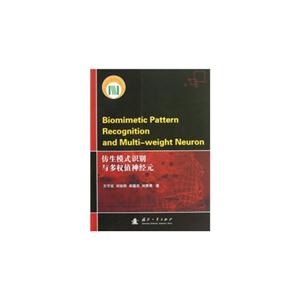-
>
全国计算机等级考试最新真考题库模拟考场及详解·二级MSOffice高级应用
-
>
决战行测5000题(言语理解与表达)
-
>
软件性能测试.分析与调优实践之路
-
>
第一行代码Android
-
>
JAVA持续交付
-
>
EXCEL最强教科书(完全版)(全彩印刷)
-
>
深度学习
仿生模式识别与多权值神经元 版权信息
- ISBN:9787118080810
- 条形码:9787118080810 ; 978-7-118-08081-0
- 装帧:一般胶版纸
- 册数:暂无
- 重量:暂无
- 所属分类:>
仿生模式识别与多权值神经元 本书特色
王守觉编著的《仿生模式识别与多权值神经元》简介:This book is the second one after the first book named "First Step to Multi-Dimensional Space Biomimetic Informatics"(in Chinese), which are both illuminating the novel biomimetic high-dimensional space geometry computing theory, but this book is more detailed and systemic. This book consists of three parts, statistical pattern recognition, biomimetic pattern recognition and multi-weight neuron. Biomimetic Pattern Recognition and Multi-weight Neuron are proposed by academician Shoujue Wang at the start of representing digital data over hundreds of dimensionality as points, and developed for five years with many applications in many fields so far.
仿生模式识别与多权值神经元 内容简介
this book is the second one after the first book named "first step to multi-dimensional space biomimetic informatics"(in chinese), which are both illuminating the novel biomimetic high-dimensional space geometry computing theory, but this book is more detailed and systemic. this book consists of three parts, statistical pattern recognition, biomimetic pattern recognition and multi-weight neuron. biomimetic pattern recognition and multi-weight neuron are proposed by academician shoujue wang at the start of representing digital data over hundreds of dimensionality as points, and developed for five years with many applications in many fields so far.
仿生模式识别与多权值神经元 目录
part i review of statistics pattern recognition
chapter 1 introduction of pattern recognition
1.1 pattern recognition concept
1.2 pattern recognition system biasic processes
1.3 a brief survey of pattern recognition appro aches
1.4 scope and organization
chapter 2 kernel of statistical pattern recognition andpre-precessing
2.1 question arise
2.1.1 question expression
2.1.2 empirical risk minimization
2.1.3 generalization ability and complexity
2.2 kernel of statistical pattern recognition
2.2.1 vapnik-chervonenkis dimension
2.2.2 the bounds of generalization ability
2.2.3 the minimization of structural risk
2.3 preprocessin9
2.4 feature extraction and feature selection
2.4.1 curse of dimensionality
2.4.2 feature extraction
2.4.3 feature selection
2.5 support vector manchine
2.5.1 the optimal hyperplane under linearly separable
2.5.2 the soft spacing under linearly nonseparable
2.5.3 the kernel function under non-linear case
2.5.4 support vector machine's traits and advantages
references
part ii biomimetic pattern recognition
chapter 3 introduction
chapter 4 the foundation of biomimetic pattern recognition
4.1 overview of high-dimensional biomimetic informatics
4.1.1 the proposal of the problem of computer imaginalthinking
4.1.2 the principle of high-dimensional biomimeticinformatics
4.2 basic contents of high-dimensional biomimetic informatics
4.3 main features of high-dimensional giomimetic informatics
4 4 concepts and mathematical symbols in high-dimensionalbiomimetic informatics
4.4.1 concepts and definitions
4.4.2 mathematical symbols
4.4.3 symbolic computing methods in resolving geometry computingproblems
4.4.4 several applications in solving complicated geometrycomputing problems
4.5 some applications
4.5.1 blurred image restoration
4.5.2 uneven lighting image correction
4.5.3 removing facial makeup disturbances
chapter 5 the theory of biomimetic pattern recognition
5.1 the concept of biomimetic pattern recognition
5.2 the choice of the name
5.3 the developments of biomimetic pattern recognition
5.4 covering.the concept of recognition in biomimetic patternrecognition
5.5 the principle of homology-continuity: the starting point ofbiomimetic pattern recognition
5.6 expansionary product
5.7 experiments
5.7.1 the architecture of the face recognition system
5.7.2 umist face data
5.7.3 pre-treatment
5.7.4 the realization of svm face recognition algorithms
5.7.5 the realization of bpr face recognition algorithms
5.7.6 experiments results and analyzes
5.8 summary
chapter 6 applications
6.1 object recognition
6 2 a multi-camera human-face personal identification system
6.3 a recognition system for speaker-independent continuousspeech
6.4 summary
references
part ⅲ multi-weight neurons and networks
chapter 7 history and definations of artificial neuralnetworks
7.1 from biological neural networks to artificial neural networksand its development
7.2 some definitions and concepts of artificial neuralnetworks
7.3 unifications and divergences between array-processors andneural networks
7.4 artificial neural networks' effects on nanoelectronicalcomputational technology
chapter 8 geometric concepts of artificial neurons
8.1 mathematical expressions of common neurons and their geometricconcepts
8.2 general mathematical model of common neurons and its geometricconcept
8.3 direction basis function neuron and its geometric concept
8.4 multi-threshold neurons and networks
chapter 9 multi-weight neurons and their applications
9.1 general mathematical expression of multi-weight neurons'functions
9.2 interchangeabilities of points, vectors, hyper planes inhigh-dimensional space
9.3 effect of high-dimensional point distribution ana
- >
巴金-再思录
巴金-再思录
¥15.7¥46.0 - >
山海经
山海经
¥18.7¥68.0 - >
我与地坛
我与地坛
¥16.4¥28.0 - >
我从未如此眷恋人间
我从未如此眷恋人间
¥16.9¥49.8 - >
回忆爱玛侬
回忆爱玛侬
¥24.0¥32.8 - >
月亮与六便士
月亮与六便士
¥19.1¥42.0 - >
小考拉的故事-套装共3册
小考拉的故事-套装共3册
¥36.7¥68.0 - >
大红狗在马戏团-大红狗克里弗-助人
大红狗在马戏团-大红狗克里弗-助人
¥5.2¥10.0
-
大模型应用开发极简入门 基于GPT-4和ChatGPT
¥41.9¥59.8 -
人工智能 现代方法 第4版(全2册)
¥120.8¥198 -
计算机视觉:算法与应用
¥95.9¥139 -
必然(修订版)
¥53.5¥89 -
GPT时代人类再腾飞
¥54.9¥89.9 -
生成式人工智能(AIGC)应用
¥64.9¥90
民国爱情传奇:师生情缘--鲁迅与许广平
¥9.3¥26.0医药器械职场突围指南
¥45.2¥59.0养生从心开始 -铁牛开讲啦
¥30.4¥42.0


















